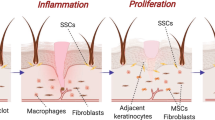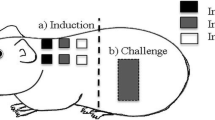Abstract
Purpose
The purpose of this study is to prepare and evaluate gene-transfected cultured skin to establish a dermal patch consisting of cultured skin as a new and novel delivery system for severely burned skin.
Materials and Methods
Plasmid DNA encoding the green fluorescent protein (GFP) gene was used as a model gene and transfected to rat and human cultured dermis models (CDMs) using the hemagglutinating virus of Japan envelope vector (HVJ-E) to prepare gene-transfected CDM and evaluate GFP expression in the CDM. Two kinds of transfection methods were evaluated. In pre-transfection, the gene was first transfected into fibroblasts and then CDM was prepared using these gene-transfected cells. In post-transfection, the gene was transfected directly into CDM.
Results
GFP expression was observed in both the pre- and post-transfected CDMs. The post-transfection method showed higher GFP expression in the CDM than pre-transfection, although no statistically significant difference was observed. The cell viability of these transfected CDMs was also examined with MTT assay. Slight decrease in viability was observed in these transfected CDMs. These methods could be useful in preparing gene-transfected cultured skins with low cell damage.
Conclusion
Gene transfection to cultured skin may produce several dermal patches that release potent endogenous bioactive peptides.







Similar content being viewed by others
References
G. Orive, R. M. Hernandez, A. Rodriguez Gascon, A. Dominguez-Gil, and J. L. Pedraz. Drug delivery in biotechnology: present and future. Curr. Opin. Biotechnol. 14:659–664 (2003).
Y. Tabata. Present position and future expectations of regenerative medicine. Biotherapy 18:91–105 (2004).
N. E. O’Connor, J. G. Muliken, S. Banks-Schlegel, O. Kehinde, and H. Green. Grafting of burns with cultured epithelium prepared from autologous epidermal cells. Lancet 1:75–78 (1981).
G. G. Gallico, N. E. O’Connor, C. C. Compton, O. Kehinde, and H. Green. Permanent coverage of large burn wounds with autologous cultured human epithelium. N. Engl. J. Med. 311:448–451 (1984).
H. Carsin, P. Ainaud, H. Le Bever, J. Rives, A. Lakhel, J. Stephanazzi, F. Lambert, and J. Perrot. Cultured epithelial autografts in extensive burn coverage of severely traumatized patients: a five year single-center experience with 30 patients. Burns 26:379–387 (2000).
Y. M. Bello, A. F. Falabella, and W. H. Eaglstein. Tissue-engineered skin. Current status in wound healing. Am. J. Clin. Dermatol. 2:305–313 (2001).
R. G. Teepe, R. W. Kreis, E. J. Koebrugge, J. A. Kempenaar, A. F. Vloemans, R. P. Hermans, H. Boxma, J. Dokter, J. Hermans, and M. Ponec. The use of cultured autologous epidermis in the treatment of extensive burn wounds. J. Trauma 30:269–275 (1990).
K. Kawai, S. Suzuki, Y. Tabata, T. Taira, Y. Ikada, and Y. Nishimura. Development of an artificial dermis preparation capable of silver sulfadiazine release. J. Biomed. Mater. Res. 57:346–356 (2001).
Y. Kuroyanagi, E. Kim, and N. Shioya. Evaluation of a synthetic wound dressing capable of releasing silver sulfadiazine. J. Burn Care Rehabil. 12:106–115 (1991).
K. Matsuda, S. Suzuki, N. Isshiki, K. Yoshioka, R. Wada, S. H. Hyon, and Y. Ikada. Evaluation of a bilayer artificial skin capable of sustained release of an antibiotic. Biomaterials 13:119–122 (1992).
Y. S. Cho, J. W. Lee, J. S. Lee, J. H. Lee, T. R. Yoon, Y. Kuroyanagi, M. H. Park, and H. J. Kim. Hyaluronic acid and silver sulfadiazine-impregnated polyurethane foams for wound dressing application. J. Mat. Sci. Mat. Med. 13:861–865 (2002).
N. Hada, T. Hasegawa, H. Takahashi, T. Ishibashi, and K. Sugibayashi. Cultured skin loaded with tetracycline HCl and chloramphenicol as dermal delivery system: mathematical evaluation of the cultured skin containing antibiotics. J. Control Release 108:341–350 (2005).
J. Harder, J. Bartels, E. Christophers, and J. M. Schroder. A peptide antibiotic from human skin. Nature 387:861 (1997).
T. Hiratsuka, M. Nakazato, Y. Date, J. Ashitani, T. Minematsu, N. Chino, and S. Matsukura. Identification of human beta-defensin-2 in respiratory tract and plasma and its increase in bacterial pneumonia. Biochem. Biophys. Res. Commun. 249:943–947 (1998).
A. Y. Liu, D. Destoumieux, A. V. Wong, C. H. Park, E. V. Valore, L. Liu, and T. Ganz. Human beta-defensin-2 production in keratinocytes is regulated by interleukin-1, bacteria, and the state of differentiation. J. Invest. Dermatol. 118:275–281 (2002).
Y. Kaneda, T. Nakajima, T. Nishikawa, S. Yamamoto, H. Ikegami, N. Suzuki, H. Nakamura, R. Morishita, and H. Kotani. Hemagglutinating virus of Japan (HVJ) envelope vector as a versatile gene delivery system. Mol. Ther. 6:219–226 (2002).
Y. Kaneda. New vector innovation for drug delivery: development of fusigenic non-viral particles. Curr. Drug Targets 4:599–602 (2003).
E. Bell, B. Ivarsson, and C. Merrill. Production of a tissue-like structure by contraction of collagen lattices by human fibroblasts of different proliferative potential in vitro. Proc. Natl. Acad. Sci. U.S.A. 76:1274–1278 (1979).
C. L. Cannon, P. J. Neal, J. A. Southee, J. Kubilus, and M. Klausner. New epidermal model for dermal irritancy testing. Toxicol. In Vitro 8:889–891 (1994).
M. Ono, Y. Sawa, Y. Miyamoto, N. Fukushima, H. Ichikawa, T. Ishizaka, Y. Kaneda, and H. Matsuda. The effect of gene transfer with hepatocyte growth factor for pulmonary vascular hypoplasia in neonatal porcine model. J. Thorac. Cardiovasc. Surg. 129:740–745 (2005).
Y. D. Kim, K. G. Park, R. Morishita, Y. Kaneda, S. Y. Kim, D. K. Song, H. S. Kim, C. W. Nam, H. C. Lee, K. U. Lee, J. Y. Park, B. W. Kim, J. G. Kim, and I. K. Lee. Liver-directed gene therapy of diabetic rats using an HVJ-E vector containing EBV plasmids expressing insulin and GLUT 2 transporter. Gene Ther. 13:216–224 (2006).
S. A. Eming, J. Lee, R. G. Snow, R. G. Tompkins, M. L. Yarmush, and J. R. Morgan. Genetically modified human epidermis overexpressing PDGF-A directs the development of a cellular and vascular connective tissue stroma when transplanted to athymic mice-implications for the use of genetically modified keratinocytes to modulate dermal regeneration. J. Invest. Dermatol. 105:756–763 (1995).
K. W. Liechty, M. Nesbit, M. Herlyn, A. Radu, N. S. Adzick, and T. M. Crombleholme. Adenoviral-mediated overexpression of platelet-derived growth factor-B corrects ischemic impaired wound healing. J. Invest. Dermatol. 113:375–383 (1999).
Y. Kaneda, S. Yamamoto, and T. Nakajima. Development of HVJ envelope vector and its application to gene therapy. Adv. Genet. 53:307–332 (2005).
D. M. Supp, S. M. Bell, J. R. Morgan, and S. T. Boyce. Genetic modification of cultured skin substitutes by transduction of human keratinocytes and fibroblasts with platelet-derived growth factor-A. Wound Repair Regen. 8:26–35 (2000).
Author information
Authors and Affiliations
Corresponding author
Rights and permissions
About this article
Cite this article
Hada, N., Todo, H., Komada, F. et al. Preparation and Evaluation of Gene-transfected Cultured Skin as a Novel Drug Delivery System for Severely Burned Skin. Pharm Res 24, 1473–1479 (2007). https://doi.org/10.1007/s11095-007-9265-9
Received:
Accepted:
Published:
Issue Date:
DOI: https://doi.org/10.1007/s11095-007-9265-9




